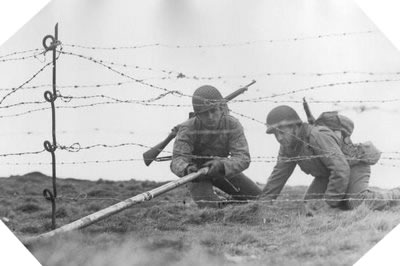Universal wire-cutting device. The Bangalore Torpedo consisted of a 1.8-m (6-ft) light steel tube of 38-mm (1 -in) diameter, packed with 1.8 kg (4 lb) of ammonal blasting explosive. The ends of the charge were prepared for detonators, while the tube had ‘male’ and ‘female’ bayonet joints at its ends, with spring locking clips, so that a number of tubes could be locked together. A conical hardwood head went into the front end of a set of tubes, while an electric detonator was fitted into the rear. This assembly-of as many tubes as required-could then be pushed along the ground and under a barbed wire entanglement, the smooth nose allowing it to slide through without snagging. Once in position, the electric detonator was fired and the entire ‘torpedo’ then detonated, blowing a gap through the entanglement.
The torpedo took its name from being invented at Bangalore, India, in 1912 by a Captain McClintock of the Indian Sappers and Miners. The Russo-Japanese war, and to a lesser extent the South African war, had introduced barbed wire to the battlefield and trials were carried out at Bangalore to deter- mine the best method of overcoming this new problem. McClintock’s torpedo was originally a 5.5-m (18-ft) length of water piping stuffed with 27.2 kg (60 lb) of dynamite which, according to legend, not only demolished the barbed wire by its blast but almost demolished the spectators as well. Suitably redesigned, the Bangalore Torpedo was widely used during the First World War and was adopted in principle by several other nations, but due to the changing style of warfare it is now virtually obsolete.
